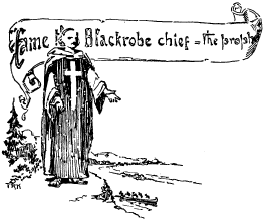|
Father Marquette Heard of Nebraska |
|
|
"Came the Black-Robe Chief, the Prophet, |
|
|
|

|
|
|
26 |
|
|
|
|
Island, May 17, 1673, with two bark canoes and five
oarsmen. They passed along the south shore of the north
peninsula of Michigan, ascended Green Bay and Fox River,
passed over the short portage to the Wisconsin and down that
river to the Mississippi. |
|
|
|
|
27 |
|
|
Michigan, at a point now occupied by the city of
Ludington, on the 18th day of May of that year. He lived in
this country eight years and eight months and was deeply
mourned by the Indians, who loved him for his gentle
christian character. |
|
 |
 |
 |
MARDOS COLLECTION
© 1999, 2000, 2001 for the NEGenWeb Project by Pam Rietsch,
T&C Miller